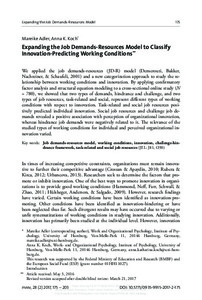Expanding the job demands-resources model to classify innovation-predicting working conditions

Adler, Mareike ; Koch, Anna K.
2017
28
2
175-203
working conditions ; innovation ; technological change
Working conditions
http://dx.doi.org/10.5771/0935-9915-2017-2-175
English
Bibliogr.
"We applied the job demands-resources (JD-R) model (Demerouti, Bakker, Nachreiner, & Schaufeli, 2001) and a new categorization approach to study the relationship between working conditions and innovation. By applying confirmatory factor analysis and structural equation modeling to a cross-sectional online study (N = 780), we showed that two types of demands, hindrance and challenge, and two types of job resources, task-related and social, represent different types of working conditions with respect to innovation. Task-related and social job resources positively predicted individual innovation. Social job resources and challenge job demands revealed a positive association with perception of organizational innovation, whereas hindrance job demands were negatively related to it. the relevance of the studied types of working conditions for individual and perceived organizational innovation varied."
Digital
The ETUI is co-funded by the European Union. Views and opinions expressed are however those of the author(s) only and do not necessarily reflect those of the European Union or the ETUI.